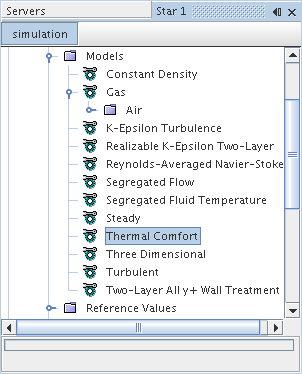What is the Thermal Comfort Model? (deprecated)
The thermal comfort model enhances simulation of passenger comfort inside a vehicle (typically an automobile).
Its capabilities for this application include :
- Passenger characteristics—height, clothing resistance, and metabolic rate
- Relative humidity
- Insulating effects of the vehicle walls
- Radiation and convection for the dashboard and other surfaces exposed to the vehicle powertrain
- Air recirculation, which uses the air humidity to evaluate the energy loads on the air conditioning system. There are certain requirements and considerations that you should note when running air recirculation simulations.
The model provides these capabilities by allowing Simcenter STAR-CCM+ to work with a special one-dimensional code called TIM (German acronym for “Thermophysiological Occupant Model”). TIM models and quantifies the thermophysiological state of a human passenger seated inside a car, or other enclosed space.
| Note | The Thermal Comfort model has been deprecated and will be removed in a future release. |
The thermal comfort model is represented with a node by that name among the physics continuum models. Its node is subject to common menu items, and appears when you activate the model.

Activating the thermal comfort model provides access to the thermal comfort wizard, which is used to define key simulation settings. Using the thermal comfort model also adds the following nodes to the object tree, which become placeholders for properties defined in the wizard:
- TCM Passengers
- TCM Boundaries
- Thermal Comfort Solver
Notes on Air Recirculation Simulations
The air recirculation feature requires the Multi-Component Gas model, with water vapor defined as the first component and dry air as the second component. You must select the components in this order, as this is how the Thermal Comfort wizard interprets the components.
The temperature and humidity of the recirculated air supplied to the air conditioning system is calculated with the following settings:
- Percentage of recirculated air from the Advanced Settings tab.
- External Humidity (relative or absolute) from the Advanced Settings tab.
- External Bulk Temperature from the External Convection and Radiation tab.
The amount of heat that needs to be removed from the air to match the temperature at the inlet is calculated as the energy load on the air conditioning system. If there are multiple inlets with different temperatures, the lowest temperature is used. In addition, if the temperature of the water vapor in the recirculated air is below the saturation temperature, the energy due to condensation is also calculated.
The total energy load on the air conditioning system is written to the air_conditioner_load.dat file after each iteration.